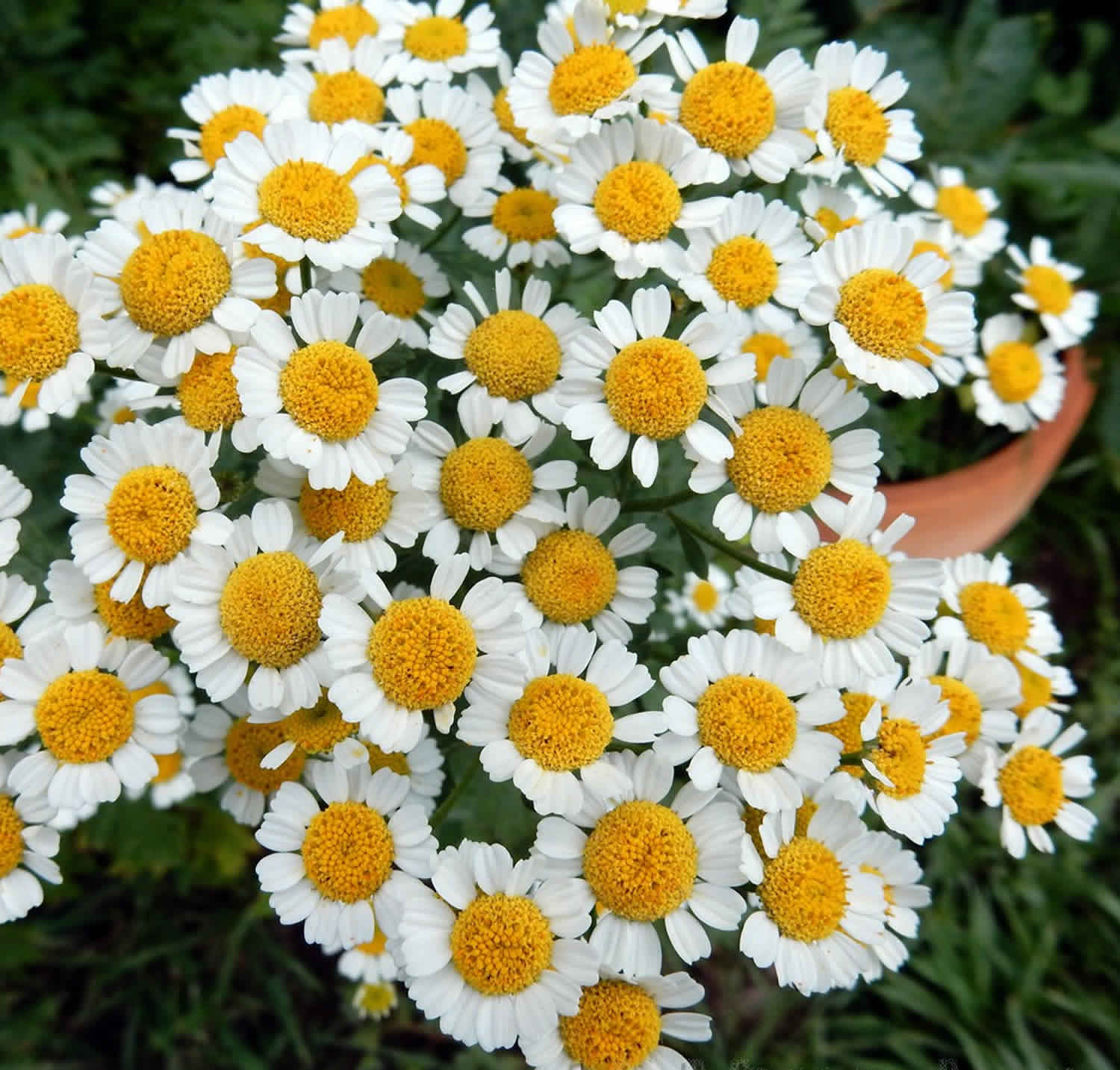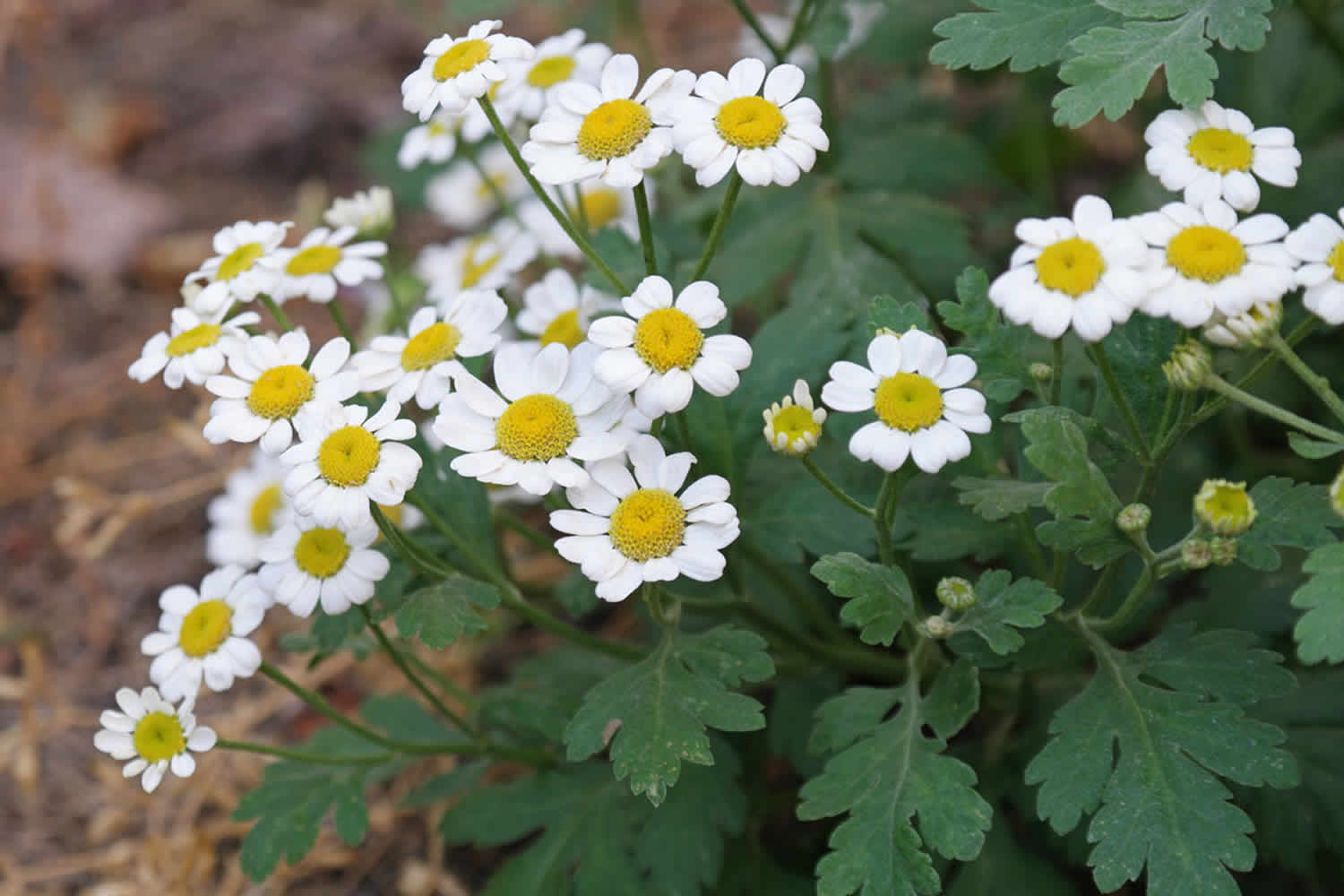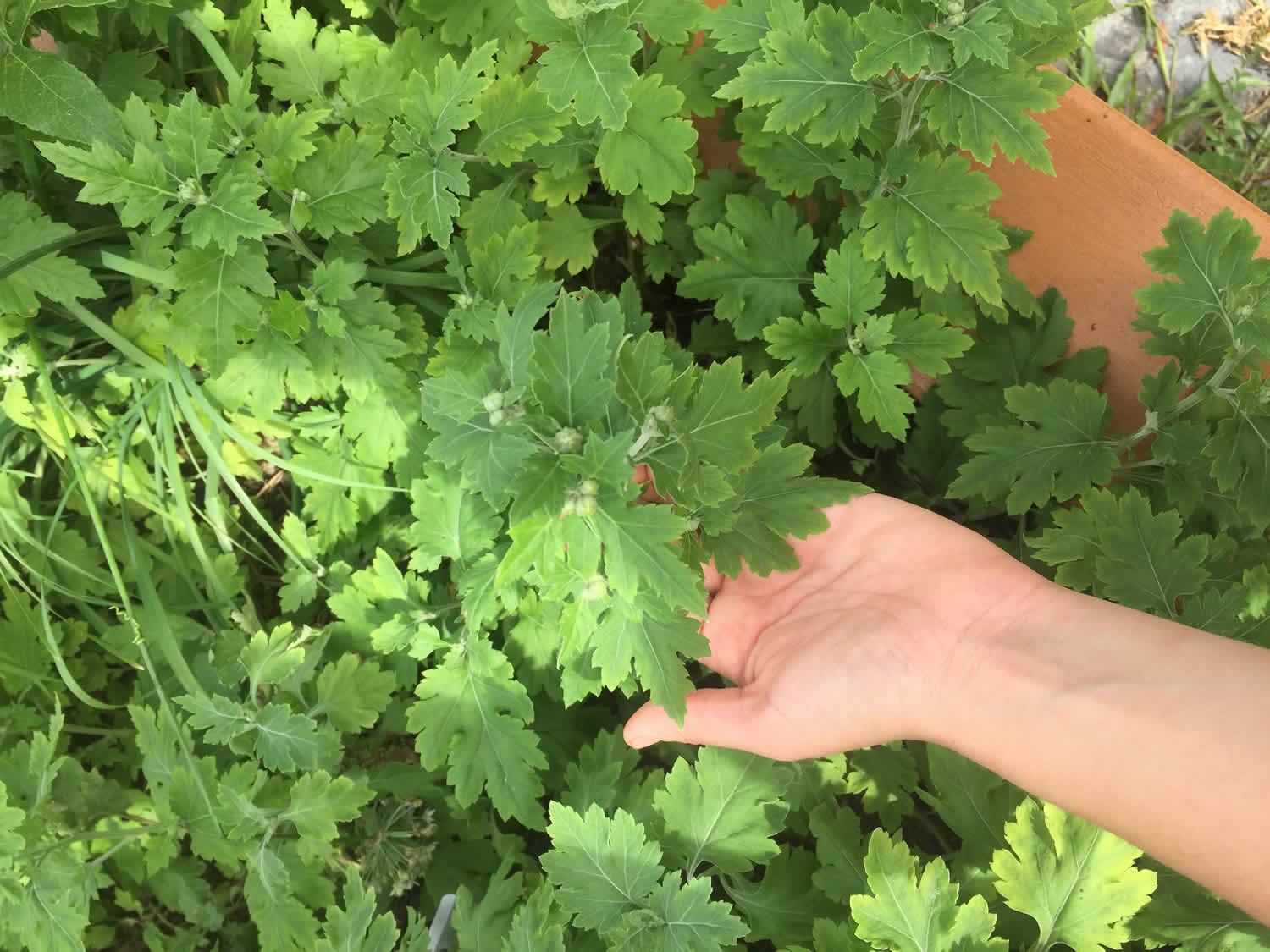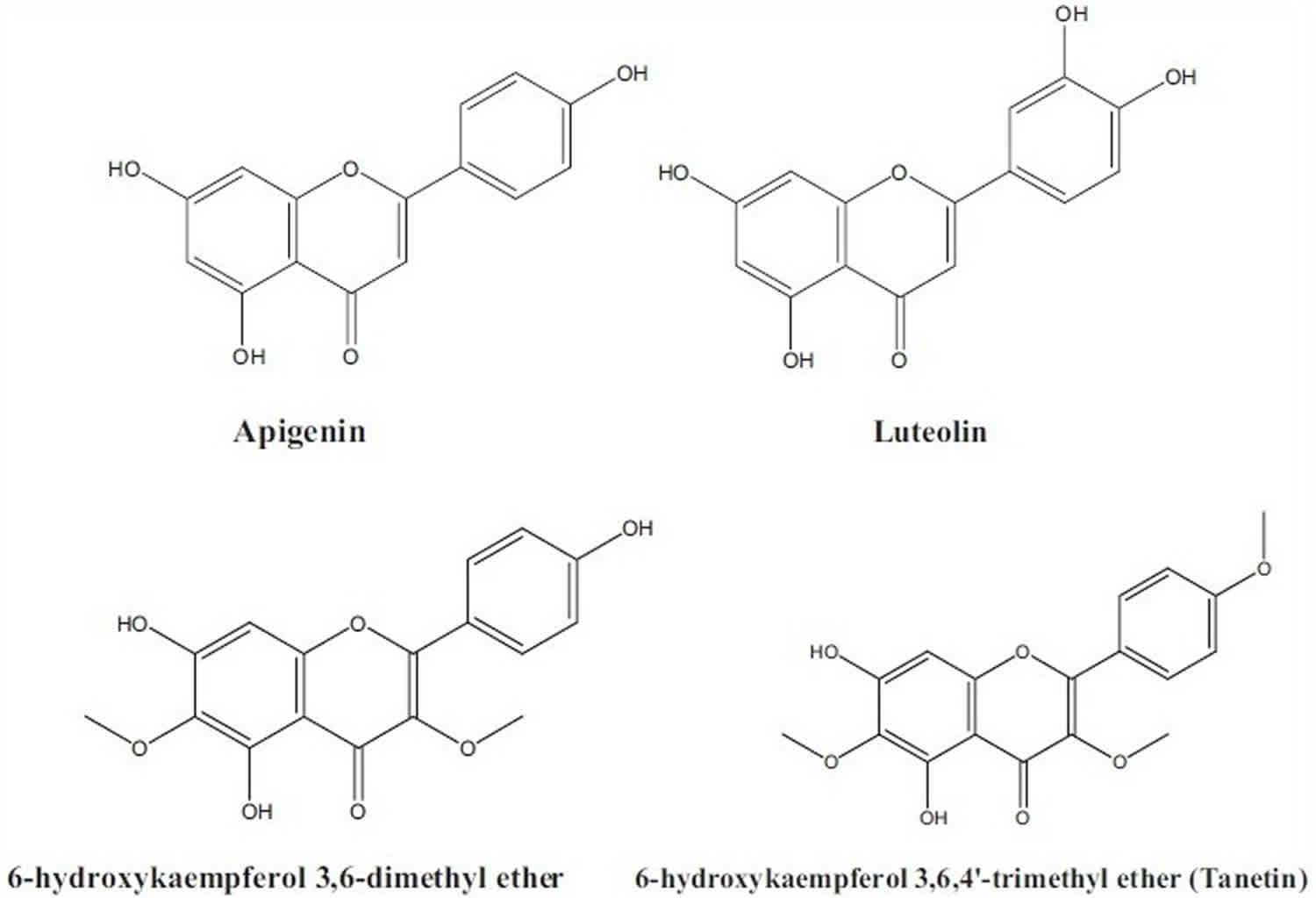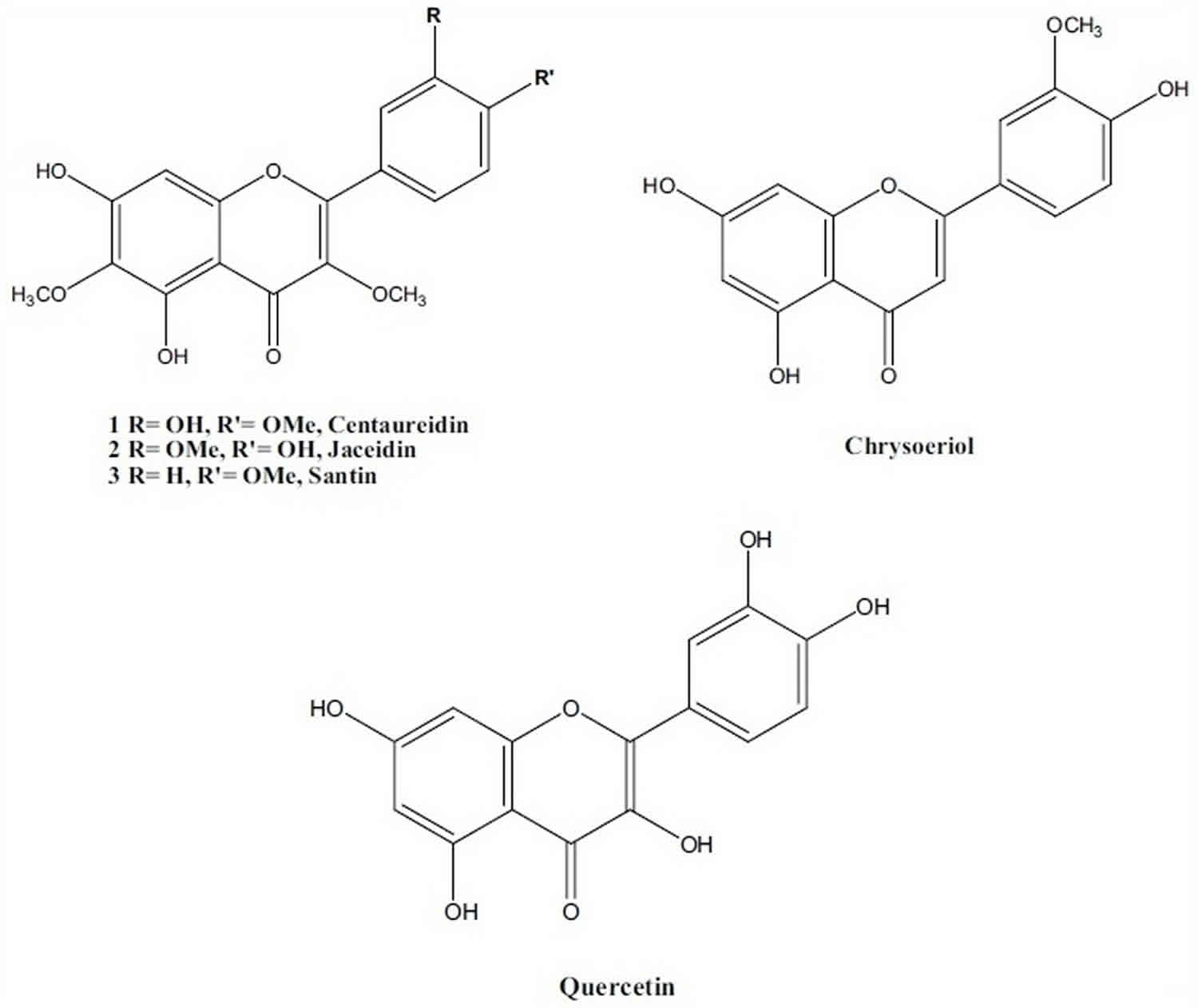Contents
What is feverfew
Feverfew (Tanacetum parthenium L.) belonging to the family Asteraceae (daisies) is a daisy-like perennial plant found commonly in gardens and along roadsides, fields, waste areas, and along the borders of woods from eastern Canada to Maryland and westward to Missouri 1. Native to the Balkan Peninsula, feverfew is now found in Australia, Europe, China, Japan, and North Africa. In the mid-19th century, feverfew was introduced in the United States. The name feverfew stems from the Latin word febrifugia, “fever reducer.” The feverfew herb has a long history of use in traditional and folk medicine, especially among Greek and early European herbalists. The first-century Greek physician Dioscorides prescribed feverfew for “all hot inflammations.” The dried feverfew leaves or aerial parts are used for medicinal purposes. Feverfew is traditionally used for the treatment of fevers, migraine headaches, rheumatoid arthritis, rheumatism, stomach aches, toothaches, insect bites, women’s ailments (infertility, and problems with menstruation and labor during childbirth) and inflammatory conditions 1. Feverfew has also been used for psoriasis, allergies, asthma, tinnitus, dizziness, nausea, and vomiting 1. Today feverfew extract is predominantly used for preventing migraine attacks and alleviating accompanying symptoms 2. It is available in different forms and preparations such as fresh feverfew leaves, powdered dried feverfew leaves, alcoholic feverfew extracts and CO2‐feverfew extract. Concerning the safety of feverfew, toxicity studies have shown that chronic prophylactic use of feverfew does not affect the frequency of chromosomal aberration in lymphocytes or urine mutagenicity 3. Anecdotal reports describe contact dermatitis 4.
Feverfew plant contains a large number of natural products, but the active principles probably include one or more of the sesquiterpene lactones known to be present, including parthenolide 1. Other potentially active constituents include flavonoid glycosides and pinenes.
Feverfew is also known as “featherfew,” because of its feathery leaves. Feverfew is a short, bushy, aromatic perennial that grows 0.3–1 m in height. Its yellow-green leaves are usually less than 8 cm in length, almost hairless, and pinnate–bipinnate (chrysanthemum-like). Feverfew yellow flowers bloom from July to October, are about 2 cm in diameter. They resemble those of chamomile (Matricaria chamomilla), for which they are sometimes confused, and have a single layer of white outer-ray florets 5. This aromatic plant gives off a strong and bitter odor. Its yellow-green leaves are alternate (in other words the leaves grow on both sides of the stem at alternating levels), and turn downward with short hairs. The small, daisy-like yellow flowers are arranged in a dense flat-topped cluster (Figure 1).
Figure 1. Feverfew herb
Feverfew herb chemistry
The chemistry of feverfew is now well defined. The most important biologically active compunds are the sesquiterpene lactones, the principal one being parthenolide. Parthenolide is found in the superficial leaf glands (0.2%–0.5%), but not in the stems, and comprises up to 85% of the total sesquiterpene content 6.
Sesquiterpene lactones
More than 30 sesquiterpene lactones have been identified in feverfew. In general, there are 5 different types of sesquiterpene lactones, which may be classified by chemical ring structures. Feverfew contains eudesmanolides, germacranolides, and guaianolides. Parthenolide is a germacranolide 7.
Researchers have also isolated the following sesquiterpene lactones: artecanin, artemorin, balchanin, canin, costunolide, 10-epicanin, epoxyartemorin, 1-beta-hydroxyarbusculin, 3-beta-hydroxycostunolide, 8-alpha-hydroxyestagiatin, 8-beta hydroxyreynosinn, 3-beta-hydroxyparthenolide, manolialide, reynosin, santamarine, epoxysantamarine, secotanaparthenolide A, secotanaparthenolide B, tanaparthin-alpha-peroxide, and 3,4-beta-epoxy-8-deoxycumambrin B 8. Other members of this class have been isolated and possess spasmolytic activity, perhaps through an inhibition of the influx of extracellular calcium into vascular smooth muscle cells (Figure 2) 9.
Figure 2. Sesquiterpene lactones of feverfew
[Source 1 ]Flavonoids
The following flavonoids have been isolated: 6-hydroxykaempferol 3,6-dimethyl ether, 6-hydroxykaempferol 3,6,4′-trimethyl ether (tanetin), quercetagetin 3,6-dimethyl ether, quercetagetin 3,6,3′-trimethyl ether (accompanied by isomeric 3,6,4′-trimethyl ether), quercetin, apigenin (also apigenin 7-glucuronide), luteolin (also luteolin 7-glucuronide), chrysoeriol, santin, jaceidin, and centaureidin (Figures 3 and 4) 10.
Figure 3. Flavonoids of feverfew herb
[Source 1 ]Figure 4. Flavonoids of feverfew herb
[Source 1 ]Volatile oils
Twenty-three compounds, representing 90.1% or more of the volatile oils, have been identified from feverfew. The primary components include camphor (56.9%), camphene (12.7%), p-cymene (5.2%), and bornyl acetate (4.6%) 1. Other components identified include tricylene, α-thujene, α-pinene, β-pinene, α-phellandrene, α-terpinene, γ-terpinene, chrysantheone, pinocarvone, borneol, terpinen-4-ol, ρ-cymen-8-ol, α-terpineol, myrtenal, carvacrol, eugenol, trans-myrtenol acetate, isobornyl 2-methyl butanoate, and caryophyllene oxide 11.
Other chemical constituents
The coumarin isofraxidin and an isofraxidin drimenyl ether named 9-epipectachol B have been isolated from the roots of the plant; (2-glyceryl)-O-coniferaldehyde also has been isolated 12.
Feverfew uses
Feverfew for migraines headache prevention
Migraine is a common, incapacitating primary headache disorder. According to the International Headache Society 13 it can be classified into two major sub‐types: migraine without aura and migraine with aura (previously called common and classical migraine). Migraine without aura manifests in attacks lasting 4 to 72 hours; the headaches are characterized by their unilateral location, pulsating quality, moderate or severe intensity, aggravation by routine physical activity and association with nausea and/or photophobia and phonophobia. Migraine with aura is primarily characterized by the focal neurological symptoms that usually precede the headache. Aura usually develops gradually over 5 to 20 minutes and last for less than 60 minutes. Headache with or without the features of migraine may accompany or follow the aura symptoms within 60 minutes 13.
The exact mechanisms of action of feverfew remain unknown. Its anti‐migraine action is probably related to its principally known bioactive ingredient, parthenolide, a sesquiterpene lactone 14. Parthenolide comprises up to 85% of the total sesquiterpene content of feverfew and is found in the leaves but not the stems 2. Parthenolides probably inhibit prostaglandin production, interfere with both contractile and relaxant mechanisms in blood vessels and perhaps inhibit the secretion of serotonin (5‐HT) 15. However, one study has suggested only a secondary role for serotonin in the cause of migraine 16. Assuming whole‐leaf preparations are effective, this would direct attention more towards other components of the feverfew leaf 17. This is also suggested by a Dutch study 18, which indicates that the essential oil constituent of feverfew, chrysanthenyl acetate, may be important. This component inhibits prostaglandin synthetase in vitro and seems to possess analgesic properties 19. Other investigators agree that parthenolide is not the only pharmacologically active constituent in feverfew 20. A link between the relatively high concentration of melatonin in different feverfew varieties 21 and a decrease in melatonin excretion during migraine attacks has been suggested 22. In conclusion, a definitive chemical link between the cause of migraine and parthenolide or any other of the feverfew constituents has still not been established 23.
As clinical trials of feverfew for the prevention of migraine attacks published in the 1980s and 1990s produced inconsistent results, wide variations in the strength of the parthenolides 24 and differences in the stability of feverfew preparations 25 were suggested as explanations. One trial using an extract of feverfew with a standardised and constant concentration of parthenolide to treat migraine did not show any beneficial effect 18. This lack of efficacy might have been due to the absence of essential therapeutic components of the granulated feverfew leaves, which were either not sufficiently extracted, or perhaps degraded during the preparation 18. Subsequently, a new, more stable feverfew extract (MIG‐99) was developed, which was used in the trials by Pfaffenrath 25 and Diener 26 but trial results were not fully consistent.
A 2015 Cochrane Review concluded that based on one larger rigorous study, feverfew reduced migraine frequency by a little more than half a migraine (0.6) per month compared to placebo 27. There was no difference in how severe the pain was, or how long it lasted. These results come from a single study of moderate size, therefore they must be viewed with caution until they are confirmed in other rigorous studies. No major adverse effects were associated with feverfew in the included studies 27. The previous 2004 version of this Cochrane review 28 showed no clear benefit of feverfew compared with placebo. Three trials administered dried powdered feverfew leaf extract at 50-100 mg/day for 8–24 weeks; 1 trial administered an alcoholic feverfew extract 143 mg/day for 8 weeks; 1 trial administered a CO2 extract (2.08 mg vs 6.25 mg vs 18.75 mg 3 times daily for 12 weeks). The 2 studies with the highest methodologic quality administered the alcoholic and CO2 extract and reported no benefit, whereas the studies with lower methodologic quality administered the dried powdered leaf extract reported a favorable response 28.
Canada’s Health Protection Branch granted a Drug Identification Number (DIN) for a British feverfew (Tanacetum parthenium L.) product, allowing the manufacturer, Herbal Laboratories Ltd, Ottawa, Canada, to claim that this nonprescription drug prevents migraine headaches 1. The agency recommends a daily dosage of 125 mg of a dried feverfew leaf preparation from authenticated feverfew (Tanacetum parthenium L.) containing at least parthenolide 0.2% for the prevention of migraine 29. Feverfew may produce an antimigraine effect in a manner similar to methysergide maleate (Sansert), a known 5-HT (serotonin) antagonist 30.
Other pharmacologic effects
Monoterpenes in the feverfew plant may exert insecticidal activity, and alpha-pinene derivatives may possess sedative and mild tranquilizing effects 1. Extracts of the plant also inhibit the release of enzymes from white cells found in inflammed joints, and a similar anti-inflammatory effect may occur in the skin, providing a rationale for the traditional use of feverfew in psoriasis.
The effect of feverfew on rheumatoid arthritis has been investigated in a double-blind, randomized, placebo-controlled trial. Forty-one women with rheumatoid arthritis were randomized to take placebo or feverfew 70–86 mg for 6 weeks. Of the 15 parameters tested, only grip strength improved significantly in the feverfew group compared with the placebo group. Human synovial fibroblasts express an intracellular adhesion molecule-1 (ICAM-1) that has been implicated in the pathogenesis of rheumatoid arthritis. Feverfew extracts or purified parthenolide inhibited the increased expression of ICAM-1 on human synovial fibroblasts by cytokines IL-1, TNF-α, and interferon-γ 31.
Anti-inflammatory activity
A proposed mechanism of action involves parthenolide specifically binding to and inhibiting IκB kinase complex (IKK)β. IKKβ plays an important role in pro-inflammatory cytokine-mediated signaling 32.
Feverfew appears to be an inhibitor of prostaglandin synthesis. Extracts of the above ground portions of the plant suppress prostaglandin production; leaf extracts inhibit prostaglandin production to a lesser extent. Neither the whole plant nor leaf extracts inhibit cyclooxygenation of arachidonic acid, the first step in prostaglandin synthesis. Chloroform leaf extracts, rich in sesquiterpene lactones, inhibit production of inflammatory prostaglandins in rat and human leukocytes. Inhibition was irreversible and the effect was not caused by cytotoxicity. Studies have shown that lipophilic compounds other than parthenolide may be associated with anti-inflammatory activity, particularly with reducing human neutrophil oxidative burst activity 33.
Tanetin, a lipophilic flavonoid found in the leaf, flower, and seed of feverfew, blocks prostaglandin synthesis. Aqueous extracts do not contribute to feverfew’s anti-inflammatory activity, but do prevent the release of arachidonic acid and inhibit in vitro aggregation of platelets stimulated by adenosine 5″-diphosphate (ADP) or thrombin. Whether or not these extracts block the synthesis of thromboxane, a prostaglandin involved in platelet aggregation, is controversial. Results suggest that feverfew’s inhibition of prostaglandin synthesis differs in mechanism from that of the salicylates 34.
Phospholipase inhibition in platelets has been documented. Inhibition of prostaglandin synthetase also has been documented for parthenolide 35.
The anti-inflammatory effects of feverfew may be caused by a cytotoxic effect. Feverfew extracts were found to inhibit mitogen-induced tritiated thymidine uptake by human peripheral blood mononuclear cells, interleukin-2-induced tritiated thymidine uptake by lymphoblasts, and prostaglandin release by interleukin-1-stimulated synovial cells. Parthenolide also blocked tritiated thymidine uptake by mitogen-induced human peripheral blood mononuclear cells 36.
Effects on vascular smooth muscle
Chloroform leaf extracts of feverfew inhibited the contraction and relaxation of rabbit aorta. The inhibition was concentration and time-dependent, noncompetitive, and irreversible, occurring with or without the presence of endothelium. The leaf extracts inhibited contractions induced by potassium depolarization much less. Only fresh leaf extracts as compared with dried powdered leaves (available commercially) inhibited the effects on smooth muscle, which was likely because of a higher concentration of parthenolide. Experiments in rat and rabbit muscle using chloroform extract from fresh leaves suggest feverfew may inhibit smooth muscle spasm by blocking open potassium channels 37.
Researchers have demonstrated that parthenolide noncompetitively inhibited serotonin (5-HT)-mediated spasmogenic response of indirect-acting 5-HT agonists in isolated rat stomach fundus preparation. Parthenolide noncompetitively antagonized the contractions elicited by the serotonergic drugs fenfluramine and dextroamphetamine on the fundal tissue. The mechanism of action associated with parthenolide does not involve the inhibition of 5-HT2 receptors directly, but rather occurs at the level of 5-HT stored in vesicles of the intramural neurons of fundal tissue 38.
Effects on platelets
Extracts of feverfew inhibit platelet serotonin (5-HT) secretion via neutralization of sulfhydryl groups inside or outside the cell. The sesquiterpenes in feverfew contain the alpha-methylenebutyrolactone unit capable of reacting with sulfhydryl groups. Feverfew extracts are not only potent inhibitors of serotonin release from platelets but also of polymorphonuclear leukocyte granules, providing a possible connection between the claimed benefit of feverfew in migraines and arthritis 39.
Inhibition of histamine release
A chloroform extract of feverfew inhibited histamine release from rat peritoneal mast cells in a different manner from established mast cell inhibitors, such as cromoglycate and quercetin. The exact mechanism of action has not been determined but may be mediated by entry of calcium into mast cells 40.
Chemotherapeutic activity
Parthenolide inhibited the growth of gram-positive bacteria, yeast, and filamentous fungi 7. A hydroalcoholic extract of feverfew inhibited the growth of Leishmania amazonesis at an IC50 of 29 μg/mL, whereas a dichloromethane fraction inhibited growth at an IC50 of 3.6 μg/mL. Parthenolide has also inhibited Mycobacterium tuberculosis and Mycobacterium avium at a minimum inhibitory concentration of 16 and 64 μg/mL, respectively 41.
Anticancer activity
Mechanisms of action may include cytotoxic action associated with interruption of DNA replication by the highly reactive lactone ring, epoxide, and methylene groups of parthenolide through inhibition of thymidine into DNA; oxidative stress, intracellular thiol depletion, endoplasmic reticulum stress, and mitochondrial dysfunction 42.
Parthenolide and similar lactones displayed anticancer activity against several human cancer cell lines, including human fibroblasts, human laryngeal carcinoma, human cells transformed with simian virus, human epidermoid cancer of the nasopharynx, and anti-Epstein–Barr early antigen activity. One study documents how parthenolide may influence and enhance the effectiveness of paclitaxel 43.
Feverfew supplement
Feverfew supplements are available fresh, freeze-dried, or dried and can be purchased in capsule, tablet, or liquid extract forms. Feverfew supplements with clinical studies contain a standardized dose of parthenolide. Feverfew supplements should be standardized to contain at least 0.2% parthenolide 1.
Feverfew dosage
Children
Feverfew should not be used in children younger than 2 years 1. In older children, adjust the recommended adult dose to account for the child’s weight. Most herbal dosages for adults are calculated on the basis of an average of 150 lb (70 kg) adult. Therefore, if the child weighs 50 lb (20–25 kg), the appropriate dose of feverfew for this child would be 1/3 of the adult dosage 1.
Adult
For migraine headaches: Take 100–300 mg, up to 4 times daily, standardized to contain 0.2–0.4% parthenolides 1. Feverfew may be used to prevent or to stop a migraine headache. Feverfew supplements may also be CO2 extracted. For these, take 6.25 mg, 3 times daily, for up to 16 weeks.
For inflammatory conditions (such as arthritis): 60-120 drops, 2 times daily of a 1:1 w/v fluid extract, or 60-120 drops twice a day of 1:5 w/v tincture 44.
Feverfew interactions
Feverfew may alter the effects of some prescription and non-prescription medications. If you are currently being treated with any of the following medications, you should not use feverfew without first talking to your health care provider 45.
Blood-thinning medications- Feverfew may inhibit the activity of platelets (a substance that plays a role in blood clotting), so individuals taking blood-thinning medications (such as aspirin and warfarin) should consult a health care provider before taking this herb 46.
Feverfew side effects
Only mild and transient adverse events, most commonly gastrointestinal complaints and mouth ulcers, were reported in the clinical trials 27. Adverse effects of patients administered feverfew 50 mg/day (roughly equivalent to 2 leaves) during 6 months of continued treatment were mild and did not result in discontinuation. Four of 8 patients taking the plant had no adverse effects. Heart rate increased dramatically (by up to 26 beats/min) in 2 treated patients. There were no differences between treatment groups in laboratory test results. Patients who switched to placebo after taking feverfew for several years experienced a cluster of nervous system reactions (eg, headaches, insomnia, joint pain, nervousness, poor sleep patterns, stiffness, tension, tiredness) along with muscle and joint stiffness, often referred to as “postfeverfew” syndrome 45.
In a larger series of feverfew users, 18% reported adverse effects, the most serious being mouth ulceration (11%). Feverfew can induce more widespread inflammation of the oral mucosa and tongue, often with lip swelling and loss of taste. Dermatitis has been associated with this plant 47.
Toxicology
No studies of chronic toxicity have been performed on the feverfew plant and the safety of long-term use has not been established 1. Pregnant women should not use the feverfew plant because the leaves have been shown to possess potential emmenagogue (stimulate menstruation) activity. It is not recommended for lactating mothers or for use in children 29.
One study evaluated the potential genotoxic effects of chronic feverfew ingestion in 30 migraine sufferers. Analysis of the frequency of chromosomal aberrations and sister chromatid exchanges in circulating lymphocytes from patients who ingested feverfew for 11 months found no unexpected aberrations, suggesting that the plant does not induce chromosomal abnormalities 48.
- Pareek A, Suthar M, Rathore GS, Bansal V. Feverfew (Tanacetum parthenium L.): A systematic review. Pharmacogn Rev. 2011;5(9):103-10. https://www.ncbi.nlm.nih.gov/pmc/articles/PMC3210009/[↩][↩][↩][↩][↩][↩][↩][↩][↩][↩][↩][↩][↩][↩][↩]
- Pareek A, Suthar M, Rathore GS, Bansal V. Feverfew (Tanacetum parthenium) L.): a systematic review. Pharmacognosy Reviews 2011;5:103‐10.[↩][↩]
- Anderson D, Jenkinson PC, Dewdney RS, Blowers SD, Johnson ES, Kadam NP. Chromosomal aberrations and sister chromatid exchanges in lymphocytes and urine mutagenicity of migraine patients: a comparison of chronic feverfew users and matched non‐users. Human Toxicology 1988;7:145‐52.[↩]
- Burry JN. Compositae dermatitis in South Australia: contact dermatitis from Chrysanthemum parthenium. Contact Dermatitis 1980;6:445.[↩]
- Jain NK, Kulkarni SK. Antinociceptive and anti-inflammatory effects of Tanacetum parthenium L.extract in mice and rats. J Ethnopharmacol. 1999;68:251–9.[↩]
- Heptinstall S, Awang DW, Dawson BA, Kindack D, Knight DW. Parthenolide Content and Bioactivity of Feverfew (Tanacetum parthenium (L.) Schultz-Bip.). Estimation of Commercial and Authenticated Feverfew Products. J Pharm Pharmacol. 1992;44:391–5.[↩]
- Chavez M, Chavez P. Feverfew. Hosp Pharm. 1999;34:436–61.[↩][↩]
- Setty AR, Sigal AH. Herbal medications commonly used in the practice of rheumatology: Mechanisms of action, efficacy, and side effects. Semin Arthritis Rheum. 2005;34:773–84.[↩]
- Begley M, Hewlett M, Knight D. Revised structures for guaianolide-methylenebutyro-lactones from feverfew. Phytochemistry. 1989;28:940–3.[↩]
- Long C, Sauleau P, David B. Bioactive flavonoids of Tanacetum parthenium revisited. Phytochemistry. 2003;64:567–9[↩]
- Akpulat H, Tepe B, Sokmen A, Daferera D, Polissiou M. Composition of the essential oils of Tanacetum argyrophyllum (C. Koch) Tvzel. var. argyrophyllum and Tanacetum parthenium (L.) Schultz Bip. (Asteraceae) from Turkey. Biochem Syst Ecol. 2005;33:511–6.[↩]
- Laiking S, Brown G. Coniferaldehyde derivatives from tissue culture of Artemisia annua and Tanacetum parthenium. Phytochemistry. 1999;50:781–5.[↩]
- Headache Classification Committee of the International Headache Society (IHS). The International Classification of Headache Disorders, 3rd edition (beta version). Cephalalgia 2013;33:629‐808.[↩][↩]
- Knight DW. Feverfew: Chemistry and biological activity. Natural Product Reports 1995;12:271‐6.[↩]
- Taylor FR. Nutraceuticals and headache: the biological basis. Headache 2011;51:484‐501.[↩]
- Goadsby PJ. How do the currently used prophylactic agents work in migraine?. Cephalalgia 1997;17:85‐92.[↩]
- Awang DVC. Prescribing therapeutic feverfew (Tanacetum parthenium (L.) Schultz‐Bip., syn. Chrysanthemum parthenium (L.) Bernh.). Integrative Medicine 1998;1:11‐3.[↩]
- Weerdt CJ, Bootsma HPR, Hendriks H. Herbal medicines in migraine prevention: randomized double‐blind placebo‐controlled crossover trial of a feverfew preparation. Phytomedicine 1996;3:225‐30.[↩][↩][↩]
- Pugh WJ, Sambo K. Prostaglandin synthetase inhibitors in feverfew. Journal of Pharmacy and Pharmacology 1988;40:743‐5.[↩]
- Brown AMG, Edwards CM, Davey MR, Power B, Lowe KC. Pharmacological activity of feverfew (Tanacetum parthenium (L.) Schultz‐Bip.): assessment by inhibition of human polymorphonuclear leucocyte chemiluminescence in‐vitro. Journal of Pharmacy and Pharmacology 1997;49:558‐61.[↩]
- Murch SJ, Simmons CB, Saxena PK. Melatonin in feverfew and other medicinal plants. Lancet 1997;350:1598‐9.[↩]
- Brun J, Claustrat B, Saddier P, Chazor G. Nocturnal melatonin excretion is decreased in patients with migraine without aura attacks associated with menses. Cephalalgia 1995;15:136‐9.[↩]
- Kuritzky A, Elhacham Y, Yerushalmi Z, Hering R. Feverfew in the treatment of migraine: its effect on serotonin uptake and platelet activity. Neurology 1994;44 Suppl 2:A201.[↩]
- Willigmann J, Freudenstein J. Production of a stable feverfew (Tanacetum parthenium) extract as an active substance for a pharmaceutical product. Internal document, Schaper Brummer GmbH and Co., 1999; Poster Symposium. Vienna: Society for Medicinal Plant Research; 1998.[↩]
- Pfaffenrath V, Diener HC, Fischer M, Friede M, Henneicke‐von Zeppelin HH. The efficacy and safety of Tanacetum parthenium (feverfew) in migraine prophylaxis ‐‐ a double‐blind, multicentre, randomized placebo‐controlled dose‐response study. Cephalalgia 2002;22:523‐32.[↩][↩]
- Diener HC, Pfaffenrath V, Schnitker J, Friede M, Henneicke‐von‐Zepelin H‐H. Efficacy and safety of 6.25 mg t.i.d. feverfew CO2‐extract (MIG‐99) in migraine prevention‐‐a randomized, double‐blind, multicentre, placebo‐controlled study. Cephalalgia 2005;25:1031‐41.[↩]
- Wider B, Pittler MH, Ernst E. Feverfew for preventing migraine. Cochrane Database of Systematic Reviews 2015, Issue 4. Art. No.: CD002286. DOI: 10.1002/14651858.CD002286.pub3.[↩][↩][↩]
- Pittler MH, Ernst E. Feverfew for preventing migraine. Cochrane Database of Systematic Reviews 2004, Issue 1. Art. No.: CD002286. DOI: 10.1002/14651858.CD002286.pub2.[↩][↩]
- Awang DV. Fever few: A headache for the consumer. HerbalGram. 1993;29:34–5.[↩][↩]
- DeWeerdt C, Bootsma H, Hendriks H. Herbal medicines in migraine prevention.Randomized double-blind placebo-controlled crossover trial of a feverfew preparation. Phytomedicine. 1996;3:225–30.[↩]
- Smith TH, Liu X. Feverfew extracts and the sesquiterpene lactone parthenolide inhibit intercellular adhesion molecule-1 expression in human synovial fibroblasts. Cell Immunol. 2001;209:89–96.[↩]
- Kwok BH, Koh B, Ndubuisi MI, Elofsson M, Crews CM. The anti-inflammatory natural product parthenolide from the medicinal herb feverfew directly binds to and inhibits IkappaB kinase. Chem Biol. 2001;8:759–66[↩]
- Brown AM, Edwards CM, Davey MR, Power JB, Lowe KC. Pharmacological activity of feverfew (Tanacetum parthenium [L.] Schultz-Bip.): Assessment by inhibition of human polymorphonuclear leukocyte chemiluminescence in vitro. J Pharm Pharmacol. 1997;49:558–61.[↩]
- Loecshe EW, Mazurov AV, Voyno-Yasenetskaya TA, Groenewegnen WA, Heptinstall S, Repin VS. Feverfew-an antithrombotic drug.? Folia Haematol Int Mag Klin Morphol Blutforsch. 1988;115:181–4.[↩]
- Pugh WJ, Sambo K. Prostaglandin synthetase inhibitors in feverfew. J Pharm Pharmacol. 1988;40:743–5.[↩]
- Neill LA, Barrett ML, Lewis GP. Extracts of feverfew inhibit mitogen-induced human peripheral blood mononuclear cell proliferation and cytokine mediated responses: A cytotoxic effect. Br J Clin Pharmacol. 1987;23:81–3.[↩]
- Barsby RW, Knight DW, McFadzean I. A chloroform extract of the herb feverfew blocks voltage-dependent potassium currents recorded from single smooth muscle cells. J Pharm Pharmacol. 1993;45:641–5.[↩]
- Bejar E. Parthenolide inhibits the contractile responses of rat stomach fundus to fenfluramine and dextroamphetamine but not serotonin. J Ethnopharmacol. 1996;50:1–12.[↩]
- Krause S, Arese P, Heptinstall S, Losche W. Influence of substances affecting cell sulfhydryl/disulfide status on adherence of human monocytes. Arzneimittelforschung. 1990;40:689–92[↩]
- Hayes NA, Foreman JC. The activity of compounds extracted from feverfew on histamine release from rat mast cells. J Pharm Pharmacol. 1987;39:466–70[↩]
- Tiuman TS, Ueda-Nakamura T, Garcia Cortez DA, Dias Filho BP, Morgado-Díaz JA, de Souza W, et al. Antileishmanial activity of parthenolide, a sesquiterpene lactone isolated from Tanacetum parthenium. Antimicrob Agents Chemother. 2005;49:176–82.[↩]
- Zhang S, Ong CN, Shen SM. Critical roles of intracellular thiols and calcium in parthenolide-induced apoptosis in human colorectal cancer cells. Cancer Lett. 2004;208:143–53[↩]
- Miglietta A, Bozzo F, Gabriel L, Bocca C. Microtubule-interfering activity of parthenolide. Chem Biol Interact. 2004;149:165–73.[↩]
- Palevitch D. Feverfew (Tanacetum parthenium) as prophylactic treatment for migraine: A double-blind placebo-controlled study. Phytother Res. 1997;11:508–11.[↩]
- Miller LG. Herbal medicinals: Selected clinical considerations focusing on known or potential drug-herb interactions. Arch Intern Med. 1998;158:2200–11.[↩][↩]
- Losche W, Mazurov AV, Heptinstall S, Groenewegen WA, Repin VS, Till U. An extract of feverfew inhibits interactions of human platelets with collagen substrates. Thromb Res. 1987;48:511–8[↩]
- Feverfew-a new drug or an old wives′ remedy? Lancet. 1985;1:1084. [↩]
- Anderson D, Jenkinson PC, Dewdney RS, Blowers SD, Johnson ES, Kadam NP. Chromosomal aberrations and sister chromatid exchanges in lymphocytes and urine mutagenicity of migraine patients: A comparison of chronic feverfew users and matched non-users. Hum Toxicol. 1988;7:145–52.[↩]
